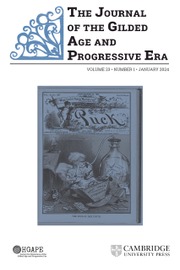Historians of slavery and abolition have long relied on memoirs, autobiographies, and other personal accounts to expand our understanding of the antislavery movement. These narratives have shaped histories of nineteenth-century intellectual, activist, and political thought. Raymond James Krohn’s Abolitionist Twilights calls attention to the challenge of analyzing retrospective writing. The work directly contradicts historians who have argued for abolitionists’ continued dedication to racial justice in the postwar period, connecting antislavery to the formation of the National Association for the Advancement of Colored People (NAACP). The legacy of abolitionism viewed through these accounts, he argues, is more nuanced and complicated. Abolitionist remembrances produced in the postwar period responded to critical turning points in American race relations. Rather than continuing calls for racial egalitarianism, white abolitionists increasingly capitulated to reconciliation narratives that pushed those ideals into the dustbin of history.
Abolitionist Twilights is organized around the writings of six abolitionist figures associated with the American Anti-Slavery Society (AASS): Samuel J. May, Oliver Johnson, Parker Pillsbury, Aaron Macy Powell, William Wells Brown, and Thomas W. Higginson. The final chapter considers less expansive narratives published by women abolitionists including Elizabeth Buffum Chace, Lucy N. Colman, Sarah H. Southwick, and Laura Smith Haviland. Central to both local and national abolitionism, these activists remained visible public figures in the postbellum period. They consciously leveraged their authorial influence to shape the memory of the movement. The resulting published works – ranging from memoirs, histories, and newspaper columns—reflected the transformation of understandings of race, civil rights, and politics in the period. Shaped by the breakdown of Reconstruction and the emerging violence of the Jim Crow era, these narratives offer fascinating glimpses into the development of abolitionism’s historical memory. Although organized chronologically, each chapter can be read as a stand alone analysis.
Krohn employs exhaustive textual analysis to facilitate a dialogue with abolitionist authors and place their writings within historical context. This work is done most effectively in his treatment of Johnson’s memorial William Lloyd Garrison and His Times (1880) and Pillsbury’s Acts of the Anti-Slavery Apostles (1883). Late nineteenth-century authors sought to define (and defend) “true” and “genuine” abolitionists. Both Johnson and Pillsbury placed Garrison at the center of abolitionist history in order to respond to contemporary debates about the legacy of abolitionism. For example, by declaring Garrison a proponent of true Christian precepts, Johnson denounced charges of radical anticlerical agitation in the prewar era. By elevating Garrison’s legacy, he also universalized the movement to make abolitionism synonymous with Garrisonianism. Likewise, Pillsbury minimized intra-abolitionist conflict to strengthen contemporary denouncements of oppressive Christian orthodoxy. Both authors also distanced themselves from the continued battle against racial injustice. Johnson shifted away from immediatism to embrace gradualism in the post-Reconstruction era, while Pillsbury relegated interracial civil rights organization to the distant past. Abolitionist Twilights ultimately concludes that former movement leaders like Johnson, Pillsbury, and Higginson, and white women abolitionist writers, were “philanthropic failures” offering only “twilight truths” of abolitionism (219–20).
Only May and Brown, Krohn argues, continued to engage with the ongoing battle against racial injustice in the postwar era. Brown, the only African American figure considered in this book, stands as an outlier, a contrast that might have been made more strongly. While memoirs written by white activists consciously omitted details to shape abolitionism’s legacy or their own, Brown’s work was fixed firmly on the future. He reacted to the changing politics of the postwar period with the express goal of refuting white, racist, or incomplete histories of slavery. His experience as a fugitive from slavery and identity as a Black American in an increasingly hostile United States no doubt shaped his unwillingness to capitulate to non-egalitarian perspectives. Although prolific in his literary productions, Brown was not the only African American abolitionist who wrote accounts of the movement in the postwar period. William Cooper Nell and Frederick Douglass stood chief among figures battling against white-washed, pseudo-scientific, and reconciliationist narratives in the post-Reconstruction era. The inclusion of additional African American figures, perhaps those whose work centered within the Black Convention movement, would further crystallize the book’s argument for the failures of white abolitionism.
Krohn includes a final chapter that briefly considers the works of Chace, Colman, Southwick, and Haviland. Women abolitionists’ accounts are placed apart due to the truncated length of their writings and his desire to link the pre-schism AASS to the postwar period. The chapter largely underscores white activists’ abandonment of Black equality but misses an opportunity to consider how gendered engagement with social movements in the postwar period influenced how men and women shaped, transformed, and leveraged the history and memory of abolition. Many Black women activists, such as intellectual Frances Ellen Watkins Harper, did not separate movements for women’s rights, temperance, anti-vice, and anti-imperialism from the intersectional egalitarian campaigns for abolition. Considering grassroots activism, the work of women’s auxiliaries and African American women activists broadly excluded from institutional membership might shed light on the remnants of abolitionism within other late nineteenth-century movements.
Krohn’s Abolitionist Twilights stands as a stark reminder to scholars to consider how the treacherous intersections of memory, nostalgia, and implicit bias often go unquestioned in well-traveled archives. It provides an impressive overview of the literary, autobiographical, and historical legacy of the antislavery movement, and highlights the necessity of further complicating the legacy of abolitionism.


